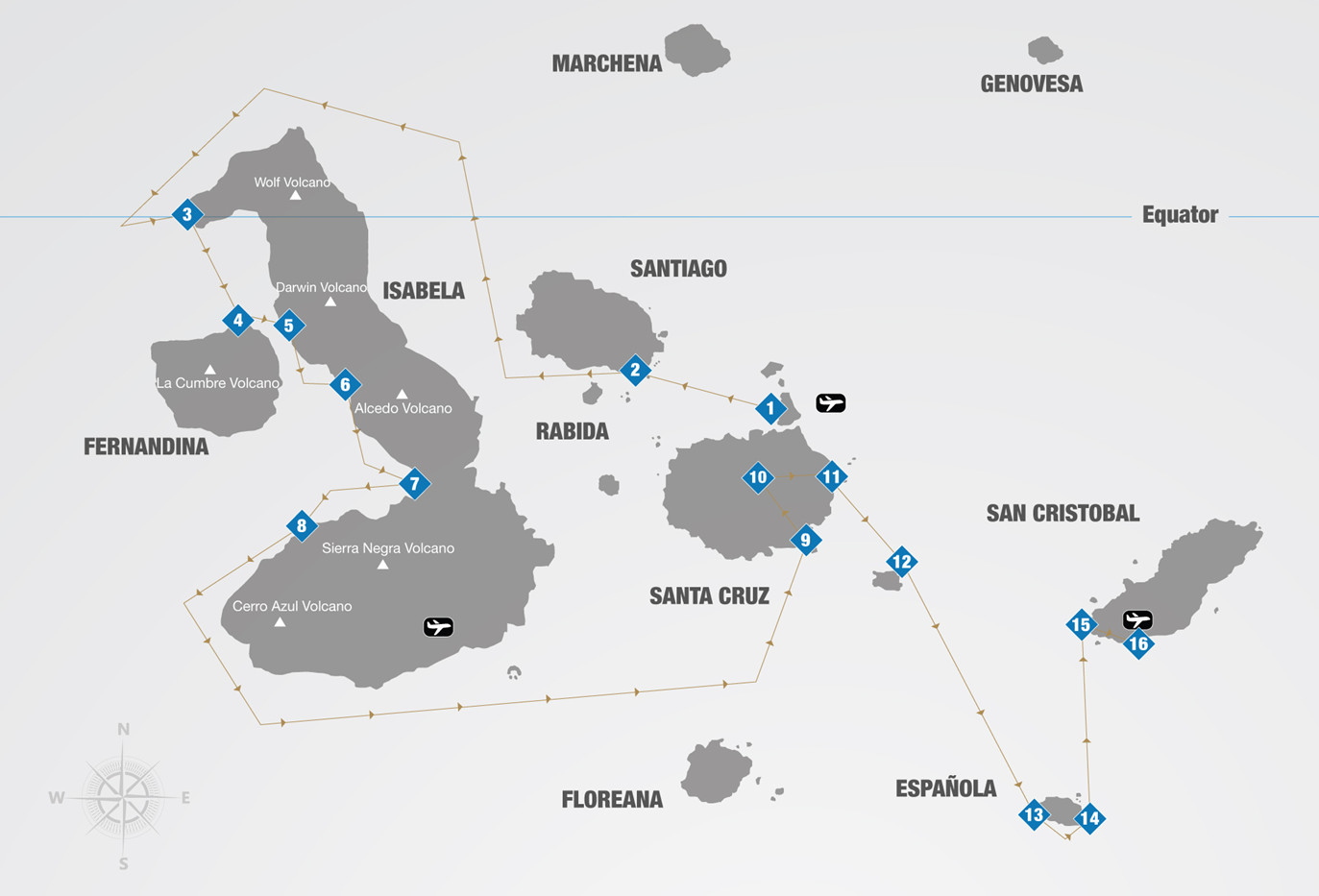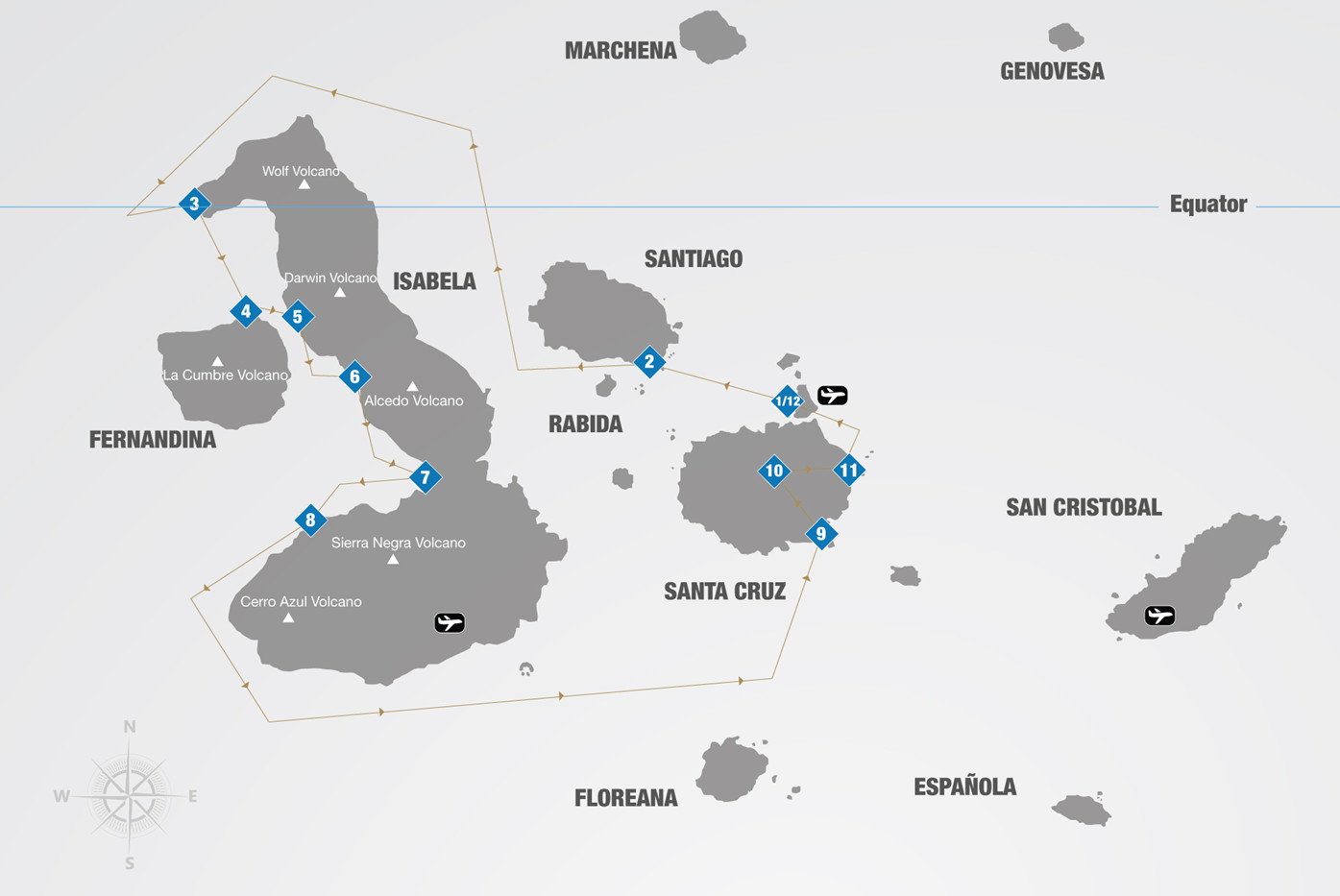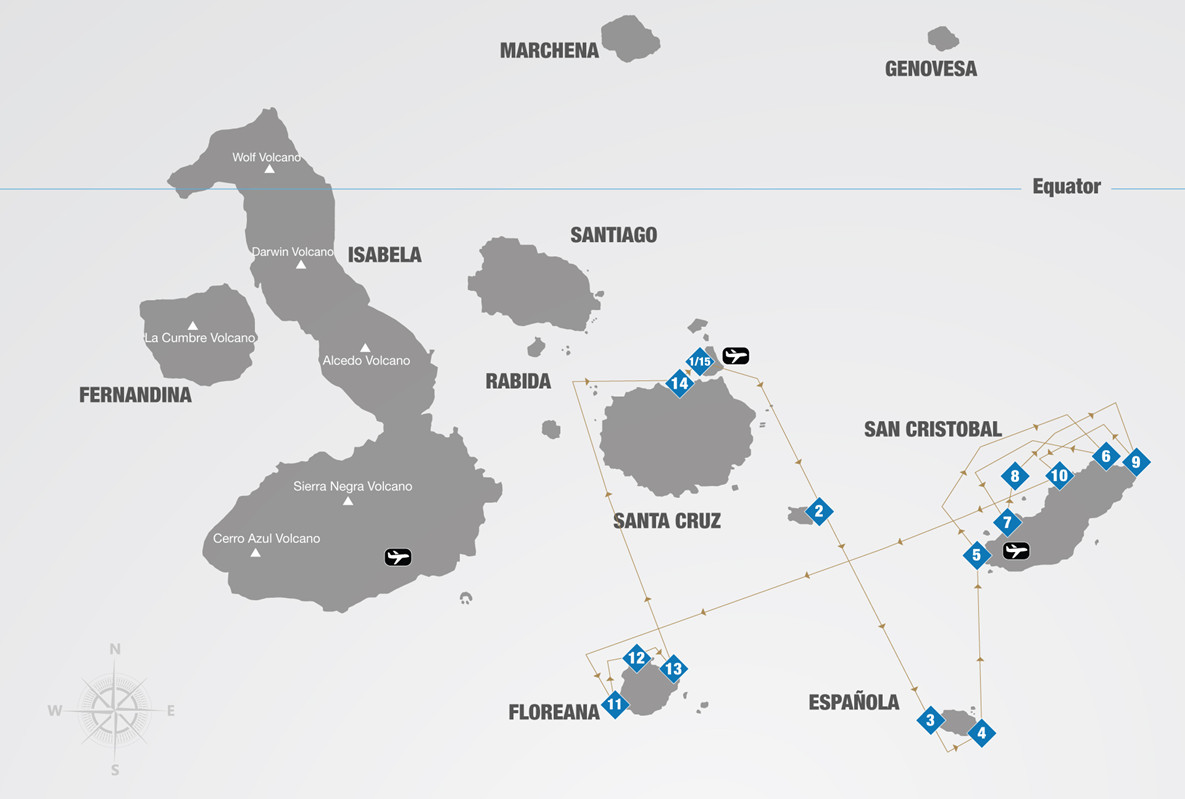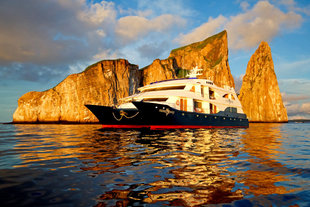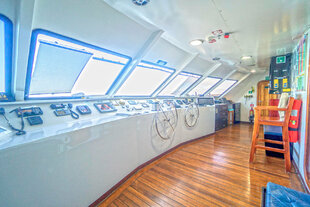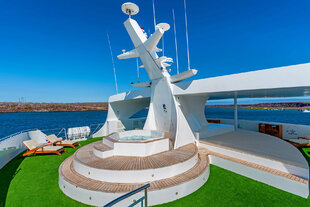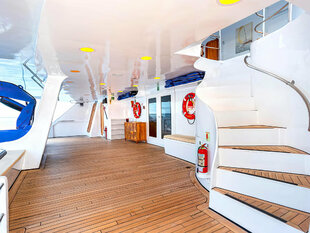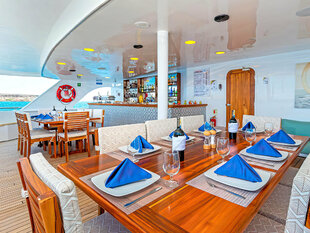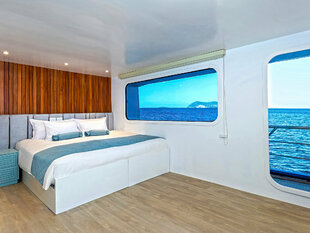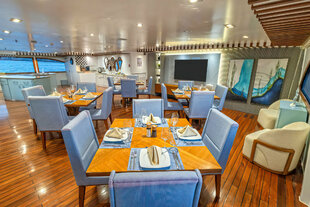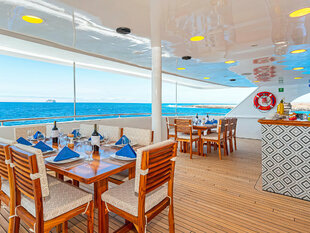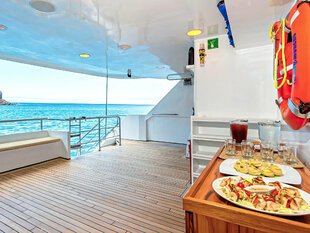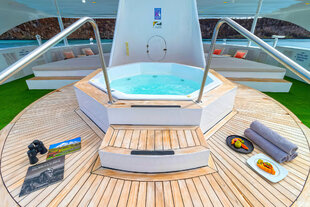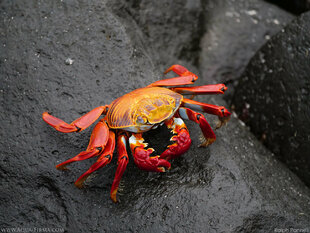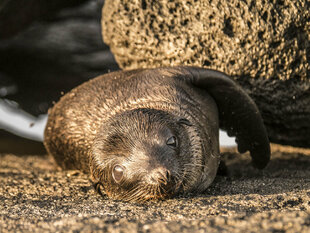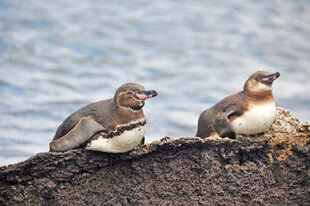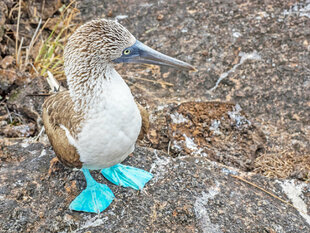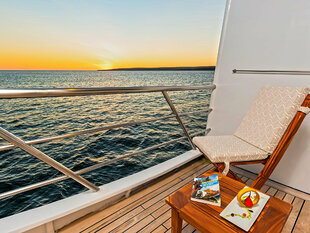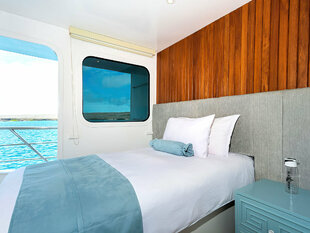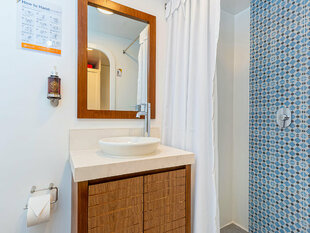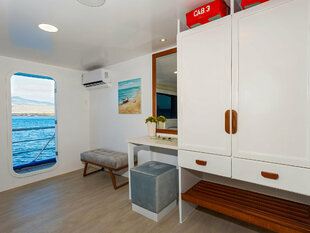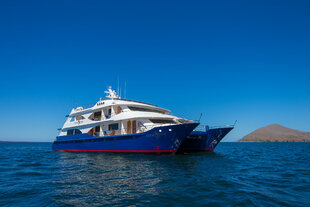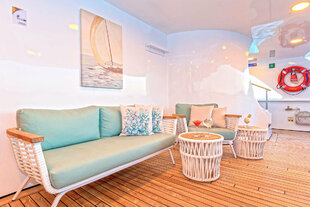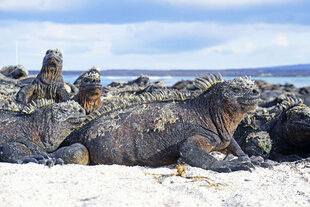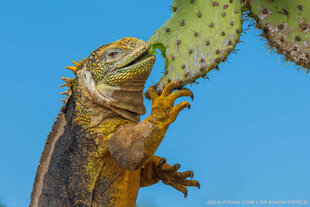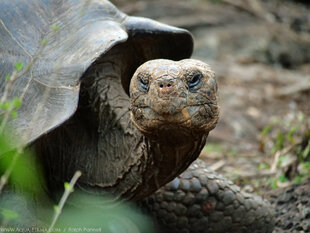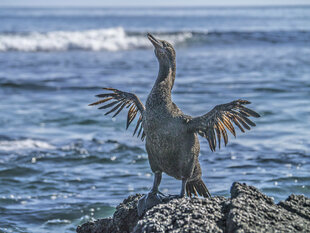Ocean Spray is a beautifully designed Mega-Catamaran, offering excellent performance, stable sailing and high-quality accommodation for up to 16 passengers. Her elegant design includes a large sun deck with sun loungers – perfect for relaxing with a drink and surveying the surrounding landscapes as well as having the added luxury of a Jacuzzi. There is also a large lounge area inside with a library and TVs.
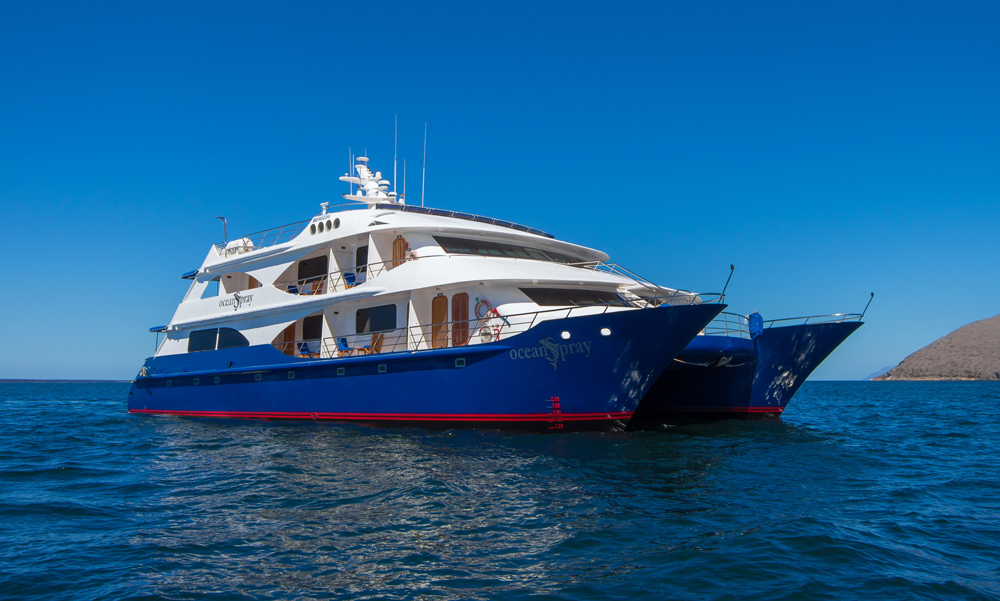
All cabins have beds which are convertible between king-size and twin. In addition, each cabin has its own private bathroom facilities, air conditioning, ample storage space, a private balcony and hot water.
Meals are freshly prepared each day by the onboard chef and served either in the inside dining room or outside in the al fresco dining area.
This ship's itineraries are primarily focused on experiencing the unique wildlife of the Galapagos Islands, with 2 cruise routes (each with length variations) taking you through different parts of the archipelago. The most common wildlife which you are likely to see on this cruise include Blue-Footed and Nazca Boobies, the Galapagos Hawk, Frigatebirds, American Flamingos, Land and Marine Iguanas, Galapagos Sea Lions, Whitetip Sharks and Sea Turtles. As well as these, there are countless other species which you may also see on one of these cruises.
To best appreciate this location, there are many different types of activities on each of the itineraries offered. Twice-daily excursions can involve hiking, snorkelling, swimming, kayaking or panga rides, enabling passengers to explore the islands from different perspectives.
Wildlife & Photography
The main focus of this trip is to experience the Galapagos’ unique wildlife and landscapes above, on and below the water. All itineraries include activities like hiking, kayaking, snorkelling, panga rides and swimming on excursions which take place twice daily, helping to give you the opportunity to explore the archipelago from different perspectives.
Each of the islands provides its own individual environment due to their age differences and stages of colonisation, which can differ by millions of years. As you make your way through any of the itineraries here, you will notice gradual changes in the landscapes and wildlife which you are surrounded by. Some of the wildlife which you can hope to see here includes Galapagos Sea Lions, Marine and Land Iguanas, Nazca and Blue-Footed Boobies, Galapagos Tortoises, Galapagos Penguins and Flightless Cormorants, among many others.
The great abundance and variety of life here makes this trip ideal for photographers. There are plenty of opportunities for every photographer to get their shots – macros of sunbathing Marine Iguanas, wide-angles of Sea Lion colonies and the islands and underwater captures of Sharks and Rays are just some of the possibilities here.
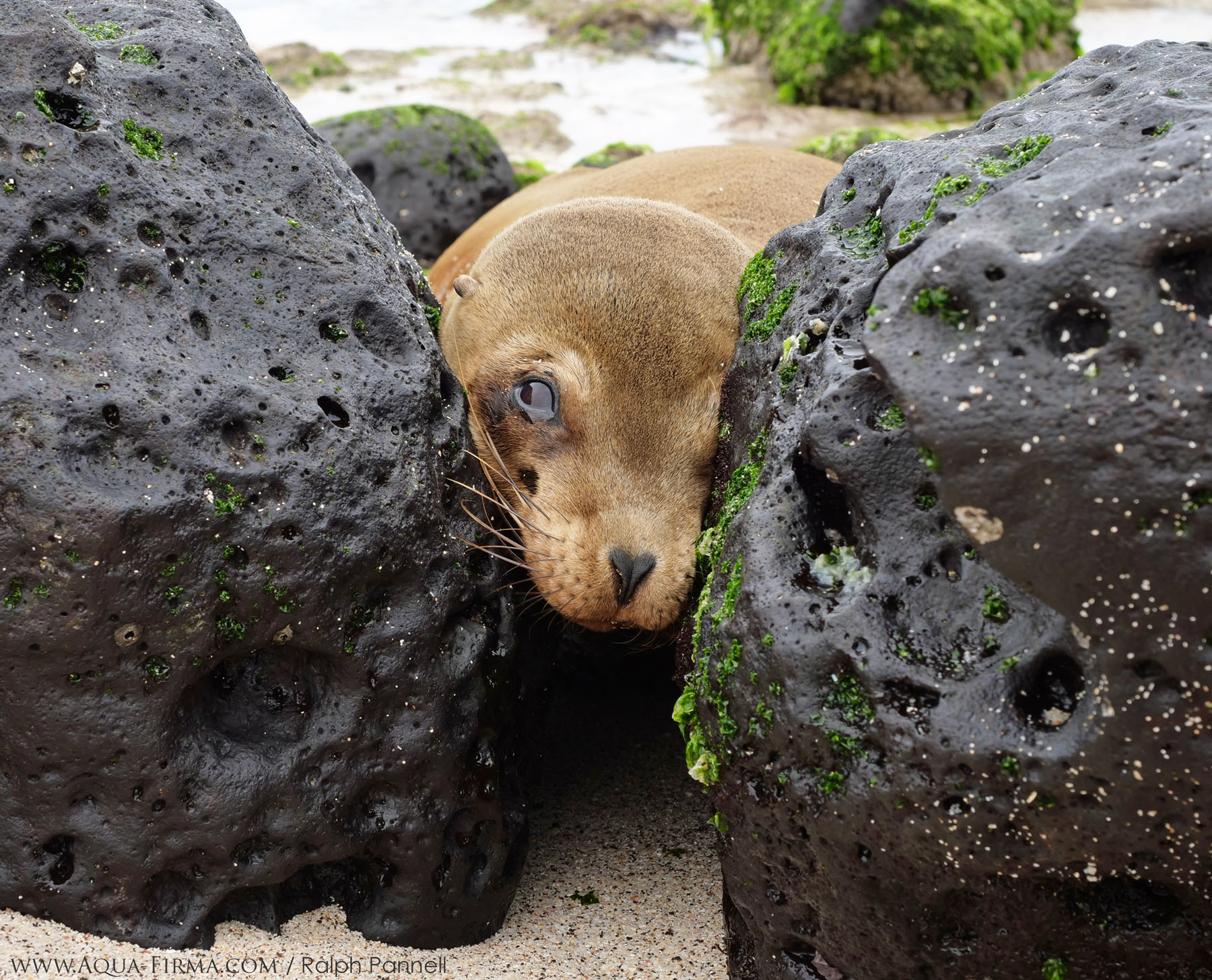
Even though the trips offered here explore a lot of the archipelago’s wonders, there are many other ways which you can explore the Galapagos Islands. If you wanted to extend your stay here to experience more of this location, you could book an add-on experience, such as a dive liveaboard from our Galapagos Dive Liveaboards page or one from our Galapagos page. We also offer trips in mainland Ecuador which you could choose to experience too.
Technical Specifications
| Construction | November 2011 |
| Type | Power motor catamaran |
| Length | 113 ft / 34 m |
| Beam | 43 ft / 13 m |
| Draft | 4 ft / 1 m |
| Weight | 170 tonnes |
| Guest capacity | Maximum 16 |
| Cabins | Main deck 4 double cabins (334 ft2 / 32 m2) Upper deck 4 double cabins (248 ft2 / 23 m2) Single cabin (194 ft2 / 18 m2) |
| Engines | MTU-DDC series 60 |
| Generators | John Deere 4.5 L |
| Top speed | 15 knots |
| Electricity | 110V AC 60Hz |
| Material | GFRP (fibre-reinforced polymer) |
| Crew | Captain, guide, quality control manager + 9 others |
| Safety & navigation | 2x 20-man life rafts Navtex 2x GPS systems Depth sounder 2x naval radars Fire detection & prevention system |
| Available gear | Kayaks, snorkelling equipment & wetsuits |
Deck Plan
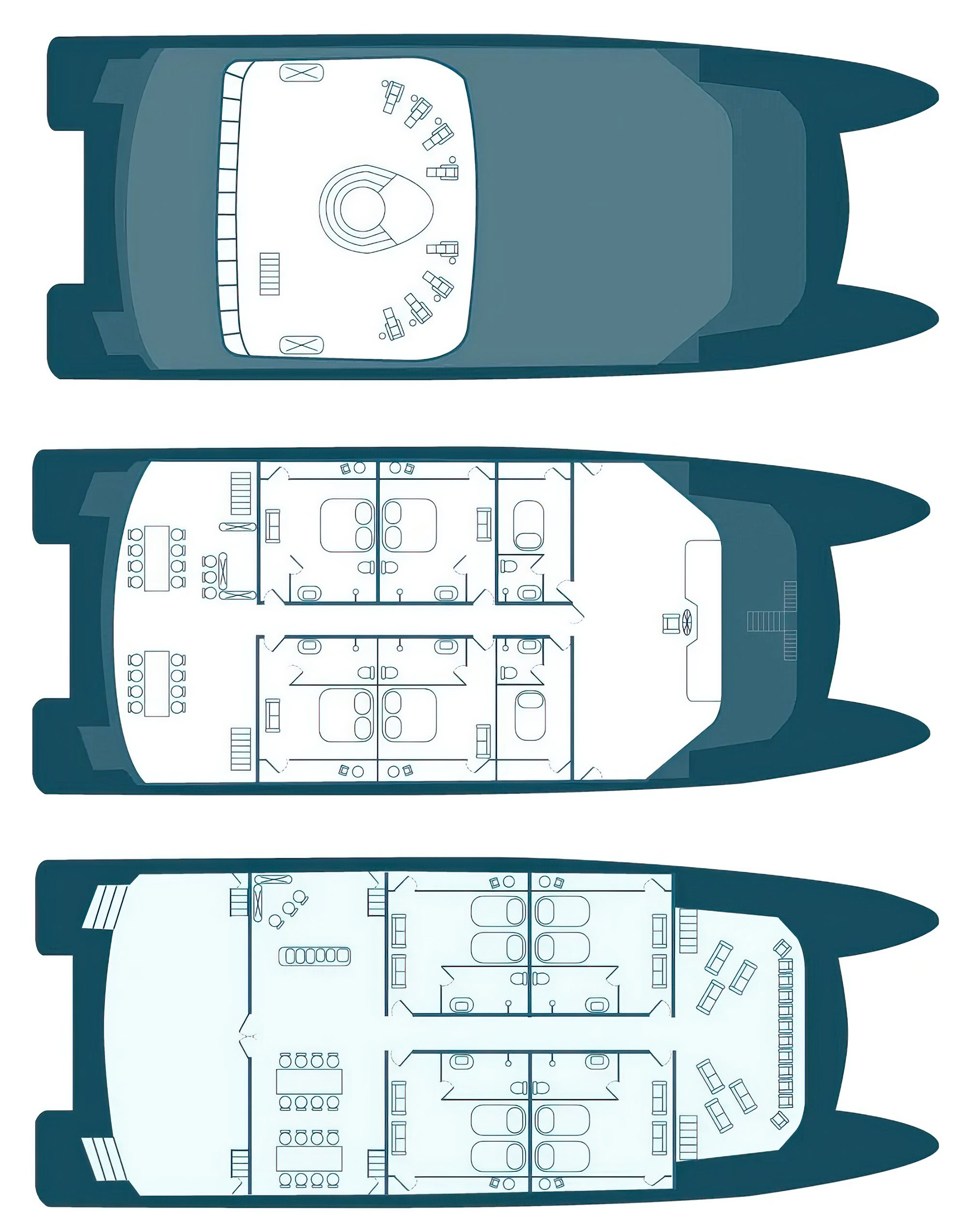
Itinerary
Please note that these itineraries are subject to change without notice due to seasonal changes, last minute weather conditions and the decision of the Galapagos National Park authority.
Day 1 (Saturday) - Arrival & Chinese Hat
AM: Arrival at Baltra Airport
Upon arrival Baltra, travellers pass through an airport inspection point to make sure that no foreign plants or animals are introduced to the islands, and to pay the park entrance fee of $200 (unless it has been prepaid). A guide will meet you, help you collect your luggage and escort you on a short bus ride to the harbour.
PM: Chinese Hat
Sombrero Chino, or Chinese Hat, aptly named due to its slowly sloping sides giving the island an appearance resembling that of a Chinese hat, is one of the smallest in the peninsula. The recent formation of the island gives it a unique environment where there are different stages of colonisation by pioneer species at this location compared to others you will have visited. Walking on the island is a great way to experience the island’s wildlife, including Sally Lightfoot Crabs, Marine Iguanas, Galapagos Sea Lions & Lava Lizards. Out of the cracks in dried-up lava, lava cacti are a common sight. The waters of the island are calm & home to White-Tip Reef Sharks, so there is ample opportunity for snorkelling & kayaking here too.
Day 2 (Sunday) – Vicente Roca Point & Espinosa Point
AM: Vicente Roca Point, Isabela Island
Galapagos Blue-footed Boobies Isabela Island: This is the largest of all the Galapagos Islands, about 120 km long, and is peculiarly shaped like a sea-horse! It is one of the few islands that are populated. The last census that was taken estimated about 2,200 people living on the Southern part of the Island. The island was formed by 6 different shield volcanoes from North to South that erupted continuously, eventually joining together to form on entire land mass. Of all the islands in the archipelago, Isabela is the most active with the latest eruption coming from Wolf Volcano in May of 2015. There are lots of unique wildlife on Isabela such as the pink iguana, and more wild tortoises than any other island with a different type of species near each of the 6 volcanoes.
On Vicente Roca Point the geological formations are simply outstanding and it is a great place to view various bird species such as blue-footed boobies, Nazca boobies, gulls, storm petrels, and brown noddy terns. Activities here are all done on the water by either dinghy or panga, or snorkeling. On this western part of the island the Cromwell Current provides cold water and many nutrients. Due to this it is possible to see various feeding frenzies of an assortment of animals such as whales, dolphins, sea lions, and marine birds diving. At times it may also be likely to see fur seals.
PM: Espinosa Point, Fernandina Island
Fernandina Island: No foreign species have ever invaded Fernandina Island and therefore it is one of the world’s most pristine island ecosystems. It is one of the most active islands and is the westernmost island in the archipelago. The volcano “La Cumbre” dominates the landscape with lava fields reaching the ocean. The Cromwell Current also flows on the west making the cold and nutrient rich water an ideal habitat for the Galapagos Penguin and Flightless Camila that nests here.
Punta Espinoza is located at the northeastern tip of the island. Here, marine iguanas conglomerate in larger groups than on any other island. They bask around in the sand, swim near the shore and sometimes block the way at the landing dock. Among the unique species found here, we can find the flightless cormorant and the Galapagos Hawk. Land iguanas are found on the inner parts of the island near the volcanoes caldera and marine iguanas will nest on the coast during certain times of the year. There is only one visitor site to Fernandina which may involve a hike or snorkeling opportunity, making the rest of the island unspoiled in a most natural state.
Day 3 (Monday) - Tagus Cove & Urbina Bay
AM: Tagus Cove, Isabela Island
This visitor site is located on the upper west part of the island and was named after and English war ship that used to pass the islands in the 1800´s. This was a famous spot for many pirates and sailors who have even left their names and the names of the ship inscribed on volcanic rock. There are many different characteristics of the island here from various volcanic activities such as large volcanic rocks or small little balls of petrified rain.
A tour along the cliffs will give visitors a good chance to see the Galapagos penguin, the flightless cormorant and other seabirds. From the landing dock, it is about a 30-minute hike along the trail up to the top of the cliff from where you can view Darwin Lake, an uplifted lake saltier than the sea. You can also see several volcanoes from this location. Look carefully at the graffiti on the surrounding cliffs of the cove, done by pirates, whalers and buccaneers in past centuries! As well as a hike, you will be able to snorkel and panga here for potential sightings of Galapagos Sea Lions, Flightless Cormorants and Galapagos Penguins.
PM: Urbina Bay, Isabela Island
Just south of Tagus Cove is Urbina Bay. Urbina Bay is an interesting site due to the uplifts of the island caused by volcanic and tectonic activity. When it rose, so did the corals and reefs that were under the surface. You can still see them although they are beginning to deteriorate due to air exposure. There are chances of seeing giant tortoises, land iguanas, and more flightless cormorants near the coast. There are also 2 treks here which offer chances of seeing Galapagos Tortoises & large Land Iguanas amongst other wildlife including Flycatchers, Finches & Mockingbirds.
Day 4 (Tuesday) - Elizabeth Bay & Moreno Point
AM: Elizabeth Bay, Isabela Island
This is a marine visitor site, so the excursion has no landing point. Your panga ride starts with a visit to the Marielas islets: home to the largest and most important penguin colony in the Galapagos Islands. The excursion continues into a cove, surrounded by red mangroves, where you can admire their red roots and green leaves. Here, you might be able to observe sea turtles, flightless cormorants, spotted eagle rays, golden cownose rays, brown pelicans and sealions. You might also see Galapagos hawks soaring overhead with schools of pompano and dorado fish swimming down below.
PM: Moreno Point, Isabela Island
Moreno Point is located on the north coast of Isabela Island between the volcanoes Sierra Negra and Cerro Azul. The trail runs along a solid dry lava flow called Pahoehoe into a complex of lagoons. Its main attraction are birds, which are found around the lakes and mangroves, which you will be able to explore by snorkelling and panga.
Day 5 (Wednesday) - Charles Darwin Centre & Highlands
AM: Charles Darwin Research Station, Santa Cruz Island
Today Santa Cruz is one of the most popular tourist sites. With a population of about 12,000 Galapagos natives, it has the longest paved road in the entire archipelago. One of the biggest conservation efforts is to eliminate all non-native plants and animals that are destroying native and endemic species on the island. There is no longer any volcanic activity but that does not mean there is no evidence. Santa Cruz means holy cross, but it' s English name comes from the British vessel – Indefatigable.
Charles Darwin Research Station conducts many different research projects and provides assistance to other researchers and governmental institutions and agencies, especially the Galapagos National Park. Many of the results are later published online, in magazines, and popular scientific journals. The research station also plays a big part in educating the community and public schools in Galapagos. There is also the longtime running Giant Tortoise restoration program that includes various stages of the giant tortoise from eggs, hatchlings and adults. The main attractions here are the National Park information centre, the Van Staelen Exhibition Hall, the Breeding and Rearing Centre for young tortoises, and adult Galapagos tortoises in captivity.
PM: Santa Cruz Highlands
The road to the highlands leaves from Bellavista, a small village located a 15-minute drive from Santa Cruz’ main town of Puerto Ayora. The road passes through the Galapagos’ most productive agricultural zone, up to the National Park boundary. We find Miconia vegetation at this altitude, changing to the Fern and Sedge zone as we ascend further. With clear weather, we can enjoy beautiful scenes of rolling hills and extinct volcanic cones covered with grass and lush greenery all year round. In the Highlands is El Chato Reserve, where Giant Galapagos Tortoises can be observed in the wild – the iconic species which gave the Galapagos Islands their name. Other species to see at this reserve include Short-Eared Owls, Yellow Warblers & Finches. More elusive species which can be difficult to spot here are Galapagos Rails & Paint-Billed Crakes.
Day 6 (Thursday) - South Plaza & Santa Fe
AM: South Plaza Island
South Plaza is a beautiful island formed out of lava which bubbled up to the sea surface. It is relatively small but very diverse in its botany and very good for spotting Land Iguanas. hybrid Iguanas exist here, created through the mating of male marine iguanas and female land iguanas.
There are approximately 1,000 Galapagos Sealions on the island and birdlife is plentiful. Cliffs on the western side are nesting sites for Blue-footed and Nazca Boobies, whilst we can find Darwin's Finches amongst the rocks of the eastern side, Lava Gulls and lovely Swallow-tail Gulls. Red-billed Tropicbirds often swoop low overhead, whilst in the sea beneath the western cliffs we can often see schools of fish close to the surface.
This island can be one of the best for photography.
PM: Santa Fe Island
Located in the southeastern part of the Galapagos, this island was formed from an uplift rather than being from a volcanic origin, which is why it is mostly flat. There are some theories claiming that this could be the oldest island in the archipelago. Santa Fé is home to a number of endemic species like the Galapagos Hawk, Galapagos snake, Galapagos mockingbird, rice rats and one of the two species of land iguanas on the islands. After disembarking into the beautiful and clear waters, you will be in contact with one of the many sea lion colonies. Along the trail, many saltbushes can be seen, as well some particularly impressive giant Opuntia cacti ‘trees’.
The island is some 24 km2 in area and a maximum 60 metres above sea level. The waters which surround it can be a lovely turquoise blue, with a protective barrier of rocks creating a semi-lagoon which is ideal for sealions.
Day 7 (Friday) - Suarez Point & Gardner Bay / Osborn Islet
AM: Suarez Point, Española Island
Here lies the southernmost island in the Galapagos, as well as the oldest. It is estimated to be about four million years old. Because it is so far away from the other islands it has the most endemic species. It is a wonderful opportunity for some great photography of endemic bird species that are found only on Espanola and awesome landscapes created by millions of years of erosion.
Punta Suarez is a phenomenal site where you will get to see many of Española Island's endemic species. The trail will pass by the only Waved Albatross breeding site. If you are lucky you might see a young albatross take off for its first flight for up to five years at sea. Older birds stay at sea for months at a time, only coming back to breed. They have the same mate for life and will meet each other each year, only here to reproduce. Other species that can be seen are marine iguanas that stay brightly colored year round, Galapagos doves, Nazca boobies, blue-footed boobies, swallow-tailed gulls, red-billed tropic birds, and Darwin finches.
PM: Gardner Bay / Osborn Islet, Española Island
The striking white beach at Gardner Bay is an important breeding site for Pacific green turtles. However, without doubt its main attraction is the Galapagos sea lion colony. Females stay year-round in this nursery, suckling their pups up to an age of 3 years, although they start to fish after 5 months of their birth. During the breeding and mating season, the colony becomes even bigger.
Osborn Islet is just southeast of Gardner Bay where a similar snorkelling quality to Gardner Islet can be expected. You will be able to see Parrotfish, Sea Lions, Butterfly Fish and more.
Day 8 (Saturday) - Interpretation Centre / Galapaguera & Departure
AM: Interpretation Centre, San Cristobal Island
San Cristobal Island is the fifth largest island in the Galapagos and lies farthest East. It is where Darwin first landed back in 1835 and where the first permanent settlements were founded. Today the main port Puerto Baquerizo Moreno is the capital of the Galapagos province and houses many government offices, the Ecuadorian Navy, and an airport with daily flights to the mainland of Ecuador. Conservation challenges the island faces include invasive plants like blackberry and guayaba and insects like the blackfly.
The San Cristóbal Interpretation Centre just outside the provincial capital of Puerto Baquerizo Moreno, is a perfect complement to the field explanations and briefings of your naturalist guide and host. Information panels are in English and Spanish, with many photographs, models and true to life dioramas which tell the background story of the islands in different ways. They really capture what makes the Galapagos Islands so unique. The well-maintained botanical garden with native species from the arid zone (including the giant prickly pear and candelabra cacti) is worth your visit as well; and you will probably spot the Chatham Mockingbird which is endemic to this island - a bird which put Darwin on track to his theory of evolution. The attractive exhibition is quite complete and explains a series of natural circumstances that create the Galapagos’ unique environment: such as the volcanic genesis of the islands, their remoteness from the continent, its ocean currents, its special climate, the arrival of different species, and their establishment, among others. It also recounts historic discovery and attempts of colonisation; and shows a diorama with ancient mail barrels from Post Office Bay.
PM: Transfer to San Cristobal Airport
Your cruise has officially come to an end. We hope you enjoyed your Galapagos Cruise! We will now transfer you to your scheduled departure from San Cristobal Airport to mainland Ecuador. Safe travels!
Itinerary B (8 days / 7 nights)
This itinerary is equivalent to itinerary F + itinerary E.
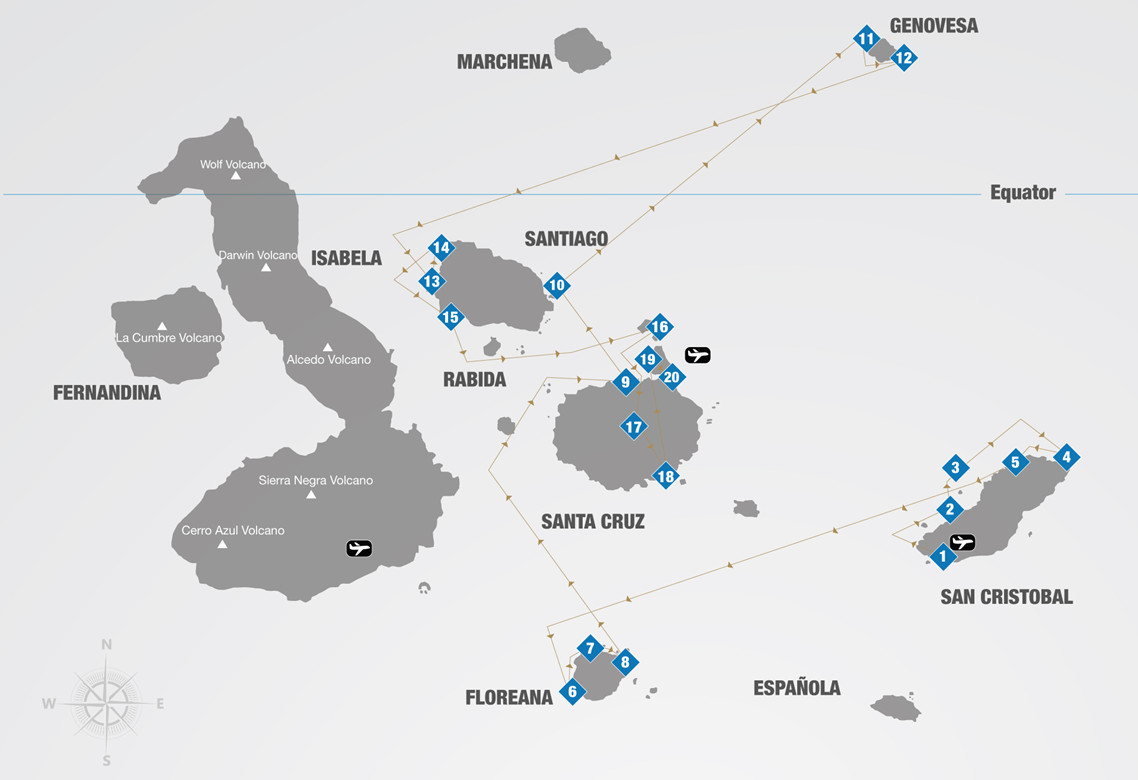
Day 1 (Saturday) – Arrival and Lobos Island/Kicker Rock
AM: Arrival at San Cristobal Airport, San Cristobal Island
Land at San Cristobal airport where you will be directed towards the airport terminal building. You will need to queue here to pay your Galapagos National Park fee and have your luggage inspected for potential contaminants to the island, such as plant matter or seeds.
Please wait for you baggage to be unloaded. Collect it and then look for someone holding a card with your name or the name of your Galapagos yacht: Ocean Spray.
PM: Los Lobos Islet / Kicker Rock, San Cristobal Island
San Cristobal Island is the fifth largest island in the Galapagos and lies farthest East. It is where Darwin first landed back in 1835 and where the first permanent settlements were founded. Today the main port Puerto Baquerizo Moreno is the capital of the Galapagos province and houses many government offices, the Ecuadorian Navy, and an airport with daily flights to the mainland of Ecuador. Conservation challenges the island faces include invasive plants like blackberry and guayaba and insects like the blackfly.
The Lobos Islet’s beach harbours a colony of Galapagos sea lions. As in other colonies in the archipelago, you can approach nurturing females within a few metres. In the breeding season this colony is also visited by territorial males, defending and mating the harem on their section of beach. This low islet is home to more than just Galapagos sea lions. Two other emblematic species breed here: male blue-footed boobies and great frigate birds. In season, booby males try to impress females with clumsy dances, showing off how blue (and healthy) their feet are. Male frigatebirds inflate and wobble huge red throat poaches called gulas. Young fluffy offspring cry for food, whilst juveniles try out their wings ready to fly.
Kicker Rock is the remnant of a volcanic tuff cone about a 90-minute boat ride out from San Cristobal Island. Its sheer cliffs rise 150 metres above the sea surface, all around and through a giant split between its two sections. Above water, the rock itself and birdlife are of interest; but best of all you need to snorkel or scuba dive here. Underwater there is rich life on some of the rock walls – great places for fish life and an incredible number of Pacific green turtles. In other parts there are some impressive caverns and swim throughs which you might enjoy in the company of Galapagos sealions.
The variable currents here attract other marine highlights such as Spotted Eagle Rays and schools of Galapagos sharks. This is also one of the best spots to hope to snorkel with hammerhead sharks. They tend to stay about 6 metres or so beneath the surface, so keep a good watch and be prepared to duck dive.
Day 2 (Sunday) - Pitt Point & Witch Hill
AM: Pitt Point, San Cristobal Island
Pitt Point is a stunning area with olivine beach contrasted against volcanic tuff making it great as a location for experiencing from both land and water. It is a haven for many sea birds which nest along its coastline. It is one of the few places in the Galapagos where you can see all 3 types of Boobies. Even more unique, it is also home to Frigatebirds & a Sea Lion colony.
PM: Witch Hill, San Cristobal Island
The primary attraction of this site is the coral sand beach, an excellent place to swim and snorkel. Witch Hill is the remains of a tuff cone and one of the first sites visited by Charles Darwin. It has an impressive landscape, where it is often possible to see coastal and migratory birds, including pelicans, blue-footed boobies and swallow-tailed gulls. There are sealions and marine iguanas here too. At times, the lagoon is completely dry and deposits of salt can be found at the bottom. The people of Puerto Baquerizo Moreno used to use the lagoon as a salt mine.
Day 3 (Monday) - Post Office Bay & Camila Point / Devil's Crown
AM: Post Office Bay, Floreana Island
Floreana Island is one of the most interesting when it comes to human history. The first Galapagos resident was an Irishman who lived on Floreana from 1807 to 1809. It is the site of the first post office within the islands created by whalers in the 1700's. Later it became the first island to be colonized by Ecuadorians, but to this day is still very isolated. Surrounded by mystery, in the 1930's various disappearances occurred and is thought to be because of tension between a baroness and her three servants who arrived after an already settled husband and wife, who gave birth to the first to be born in Galapagos and another couple of a doctor and female companion who lived of the land from their garden. The small population of today lives off the land with home grown farms and gets their water from rain filled ponds during the rainy season. There is one hotel with the only phone in the port of Velasco Ibarra where most residents live, the rest live up in the highlands. Transportation is limited and is only available every two weeks.
Post Office Bay is primarily of cultural significance. In times before there was a reliable postal service, a barrel onshore was a point where British 16th century whalers and poachers could post a letter. You are encouraged to write and address one or two post cards; whilst at the same time picking out any which are addressed close to your home, which you are happy to hand deliver when you return.
Shallow waters offshore are lovely to swim in. If you doon a mask and snorkel, you might see Pacific green turtles which often graze here.
PM: Cormorant Point / Devil's Crown, Floreana Island
The peninsula of Punta Cormorant (Cormorant Point) marks the extreme northern cape of Floreana – an island formed from smaller volcanic cones, covered now by tropical dry forest (palo santo). At the landing beach, you are likely to be welcomed by a small colony of Galapagos sealions. The green sand on this beach contains a high percentage of glassy olivine crystals which have been blown out by the surrounding tuff cones.
The ‘flour sand’ beach on the southern side of the peninsula is made up of white coral ground into sand by Parrotfish. It feels very smooth on the feet. You may be able to spot stingrays who use the sandy bottom to bury themselves. During the first months of the year, Pacific green turtles come ashore to dig a nest in which to bury their eggs.
Devil’s Crown is a small outcrop of rocks off the coast of Floreana near Cormorant Point with a circular arrangement which gives them their name. Here, there is spectacular snorkelling with an abundance of reef fish such as Parrotfish, Surgeonfish & King Angelfish as well as Manta Rays & Sharks, including Hammerhead Sharks.
Day 4 (Tuesday) - Black Turtle Cove & Bartolomew Island
AM: Caleta Tortuga Negra, Santa Cruz Island
Black Turtle Cove is located on the north side of Santa Cruz Island and is only accessible by boat and with a guide. This shallow inlet is surrounded by mangroves and provides natural protection for a variety of marine life, attracting the vulnerable juveniles of many species. Below the surface of the water, you can see both black-tip and white-tip reef sharks, sea turtles, golden cow-nose rays, spotted eagle rays, and an occasional hammerhead shark. Pelicans and Boobies hunt here, diving gracefully into the water.
PM: Pinncale Rock, Bartholomew Island
Bartholomew is another satellite island that derives from Santiago Island. It is home of the famous Pinnacle Rock and is named after James Sullivan, a friend of Charles Darwin who was also aboard the HMS Beagle. Of all the islands, this is the most photographed and is also featured in the 2003 movie “Master and Commander”.
Pinnacle Rock is a volcano cone formed by magma expelled by an underwater volcano. The sea cooled the hot lava and as it exploded from contact, the pieces formed together this huge rock of many, many layers of basalt. The huge rock also has a beach where a small population of green sea turtles will nest. Galapagos penguins gather here and swimming can offer beautiful sights of colorful schools of fish and curious sea lions.
Day 5 (Wednesday) - Darwin Bay & El Baranco
AM: Darwin Bay, Genovesa Island
The horse-shoe shaped Genovesa Island was formed by the eruption of a shield volcano with large slopes formed by gradual lava flows. It is known as “Bird Island” due to the wide variety of birds that can be seen. The only reptile on the entire island is the marine iguana and it is one of the very few places red-footed boobies gather in one large mass.
Darwin Bay is the result of the shield volcano where one of the sides of the caldera collapsed after years of erosion. It is one of the places in the Galapagos where red-footed boobies can be guaranteed to be seen. Over 200,000 red-footed boobies are estimated to be living in the trees and bushes of Genovesa. Inside the submerged caldera of Genovesa lies Darwin Bay, whose diameter is more than 1.5km (1 mile) and it is almost 200 m (650 ft) deep. The small area will surprise you repeatedly, walking along a coral sand beach, crossing barren lava formations and creeks, passing tidal pools, shrubs and further ahead following the top of some cliffs. With this peaceful surrounding, every species has occupied its own ecological niche (or habitat) without disturbing others. There is great birdlife here with other starring species including Great Frigatebirds & Laval Gulls. These often share the beach with Galapagos Sea Lions.
PM: El Barranco (Prince Philip's Steps), Genovesa Island
Before landing, you will take an inflatable dinghy-ride along the eastern arm of the caldera. As we approach, the soaring 25m / 80ft high walls become overwhelming. Sometimes, a Galapagos fur seal is resting or a seabird is nesting on one of the ledges at the base. You will then have to hike and overcome the steep stairs from the landing dock to a bush of palo santo shrubs on top. Red-footed boobies gratefully use these scarce nesting places so that they don’t have to nest on the rocky ground. Upon arriving at the edge of the rim, the bushes open up and you can enjoy panoramic views, a sea breeze and the amazing flying skills of countless seabirds. Following the exposed rim, you will first pass a place where we usually encounter a colony of Nazca boobies; and finally reach the extensive storm petrel nesting places. If you are lucky, you can spot the well camouflaged short-eared owl hunting for them on foot!
Day 6 (Thursday) - Espumilla Beach / Buccaneer Cove & Egas Port
AM: Espumilla Beach / Buccaneer Cove, Santiago Island
Santiago Island is the second Island visited by Charles Darwin was originally named after England's King James the second. The island was a good source of salt, water and food for whalers and buccaneers passing. There was a salt mine inland that was used to salt fish and tortoise meat. Land iguanas used to populate the island but are now extinct. From Darwin's own notes he wrote that land iguanas were thriving quite well since there was no place to even pitch a tent. Santiago Island today is now one of the most visited islands.
Espumilla Beach is an important breeding site for turtles. It suffered for a period, from feral pigs which dug up turtle nests; but the beach’ natural state has been restored so the turtles return year after year to bury their eggs into the cinnamon-coloured sand dunes. 6 weeks later, during the months of February to August, the eggs hatch.
The beach ridge hides a mangle with two lagoons on the backside. A colony of American flamingos and aquatic birds used to be its main attraction, but after a previous El Niño, strong sedimentation altered the water environment, and now no longer provides their food. Vegetation zones are very close by, providing great scenic contrasts. During the climb up a hill, you will be rewarded with a beautiful view of the transitions from sea to beach and from mangrove to a dry palo santo forest.
At the nearby Buccaneers Cove, you will have the opportunity to snorkel amongst Galapagos marine life.
PM: Egas Port, Santiago Island
Puerto Egas is a black beach located at the west side of Santiago Island. Volcanic tuff deposits formed this special black sand beach and made it the main attraction of the Island. This site is called Puerto Egas because Hector Egas attempted to exploit the salt, which failed because the price of salt on mainland South America was too low to make it a viable export. There is a trail which follows the coastline here for sightings of Marine Iguanas, Galapagos Sea Lions and many sea birds. Land Iguanas were reintroduced to the island as recently as 2019, so look out for these as you walk. At the end of the trail is a small Galapagos Fur Seal colony. If you snorkel from the beach here, you may be able to see Turtles, a range of Fish and Reef Sharks.
Day 7 (Friday) - North Seymour & Highlands
AM: North Seymour Island
North Seymour Island: The island was named after English nobleman Lord Hugh Seymour. Formed by uplifted submarine lava, the island is home to a huge colony of about 2,500 land iguanas and large populations of sea lions, blue-footed boobies, common noddies and frigatebirds. Along the coast it is possible to see land and marine iguanas and the biggest colony of Magnificent Frigatebirds.
PM: Highlands & Charles Darwin Research Station, Santa Cruz Island
The road to the highlands leaves from Bellavista, a small village located a 15-minute drive from Santa Cruz’ main town of Puerto Ayora. The road passes through the Galapagos’ most productive agricultural zone, up to the National Park boundary. We find Miconia vegetation at this altitude, changing to the Fern and Sedge zone as we ascend further. With clear weather, we can enjoy beautiful scenes of rolling hills and extinct volcanic cones covered with grass and lush greenery all year round. In the Highlands is El Chato Reserve, where Giant Galapagos Tortoises can be observed in the wild – the iconic species which gave the Galapagos Islands their name. Other species to see at this reserve include Short-Eared Owls, Yellow Warblers & Finches. More elusive species which can be difficult to spot here are Galapagos Rails & Paint-Billed Crakes.
Although the great majority of Galapagos visitors come to the Charles Darwin Research Station to observe and appreciate natural wonders, it is also interesting to learn how the protection and conservation of the islands are carried out. The main attractions are the National Park information centre, the Van Staelen Exhibition Hall, the Breeding and Rearing Centre for young tortoises, and adult Galapagos tortoises in captivity.
Day 8 (Saturday) - Mosquera Islet & Departure
AM: Mosquera Islet
Mosquera Islet is located between the islands of Baltra and North Seymour. It is a reef of rocks and coral (the result of an uprising) and a great white sand beach. Its narrowest width reaches about 160 meters and has an estimated length of 600 meters. In most of the perimeter there is a base of lava rocks, as evidence of the lava uprising, except in the southwest side where the landing occurs. This island has one of the largest populations of sea lions. You can also observe several species of shorebirds. There have been occasional reports at this site of Orcas (Orcinus orca) feeding on sea lions.
PM: Transfer to Baltra Airport
Your guide & some crew members will go with you to Baltra where you will board the airport shuttle. Your guide will remain with you through the check-in counters & departure hall.
Day 1 (Saturday) - Arrival & Chinese Hat
AM: Arrival to Baltra Airport, Baltra Island
Upon arrival Baltra, travellers pass through an airport inspection point to make sure that no foreign plants or animals are introduced to the islands, and to pay the park entrance fee of $200 (unless it has been prepaid). A guide will meet you, help you collect your luggage and escort you on a short bus ride to the harbour.
PM: Chinese Hat
Sombrero Chino, or Chinese Hat, aptly named due to its slowly sloping sides giving the island an appearance resembling that of a Chinese hat, is one of the smallest in the peninsula. The recent formation of the island gives it a unique environment where there are different stages of colonisation by pioneer species at this location compared to others you will have visited. Walking and snorkelling here are great ways to experience the island’s wildlife, including Sally Lightfoot Crabs, Marine Iguanas, Galapagos Sea Lions & Lava Lizards. Out of the cracks in dried-up lava, lava cacti are a common sight. The waters of the island are calm & home to White-Tip Reef Sharks, so there is ample opportunity for snorkelling & kayaking here too.
Day 2 (Sunday) - Vicente Roca Point & Espinosa Point
AM: Vicente Roca Point, Isabela Island
Isabela Island is the largest of all the Galapagos Islands, about 120 km long, and is peculiarly shaped like a sea-horse! It is one of the few islands that are populated. The last census that was taken estimated about 2,200 people living on the Southern part of the Island. The island was formed by 6 different shield volcanoes from North to South that erupted continuously, eventually joining together to form on entire land mass. Of all the islands in the archipelago, Isabela is the most active with the latest eruption coming from Wolf Volcano in May of 2015. There are lots of unique wildlife on Isabela such as the pink iguana, and more wild tortoises than any other island with a different type of species near each of the 6 volcanoes.
On Vicente Roca Point the geological formations are simply outstanding and it is a great place to view various bird species such as blue-footed boobies, Nazca boobies, gulls, storm petrels, and brown noddy terns. Activities here are all done on the water by either dinghy or panga, or snorkeling. On this western part of the island the Cromwell Current provides cold water and many nutrients. Due to this it is possible to see various feeding frenzies of an assortment of animals such as whales, dolphins, sea lions, and marine birds diving. At times it may also be likely to see fur seals.
PM: Espinosa Point, Fernandina Island
No foreign species have ever invaded Fernandina Island and therefore it is one of the world’s most pristine island ecosystems. It is one of the most active islands and is the westernmost island in the archipelago. The volcano “La Cumbre” dominates the landscape with lava fields reaching the ocean. The Cromwell Current also flows on the west making the cold and nutrient rich water an ideal habitat for the Galapagos Penguin and Flightless Camila that nests here.
Punta Espinoza (Espinosa Point) is an area on Fernandina which provides a great opportunity to see the Galapagos Hawk. Land iguanas are found on the inner parts of the island near the volcanoes caldera and marine iguanas will nest on the coast during certain times of the year. There is only one visitor site to Fernandina which may involve a hike or snorkeling opportunity, making the rest of the island unspoiled in a most natural state.
Day 3 (Monday) - Tagus Cove & Urbina Bay
AM: Tagus Cove, Isabela Island
Tagus Cove is located on the upper west part of the island and was named after and English war ship that used to pass the islands in the 1800’s. This was a famous spot for many pirates and sailors who have even left their names and the names of the ship inscribed on volcanic rock. There are many different characteristics of the island here from various volcanic activities such as large volcanic rocks or small little balls of petrified rain.
A tour along the cliffs will give visitors a good chance to see the Galapagos penguin, the flightless cormorant and other seabirds. From the landing dock, it is about a 30-minute hike along the trail up to the top of the cliff from where you can view Darwin Lake, an uplifted lake saltier than the sea. You can also see several volcanoes from this location. Look carefully at the graffiti on the surrounding cliffs of the cove, done by pirates, whalers and buccaneers in past centuries! As well as a hike, you will be able to snorkel and panga here for potential sightings of Galapagos Sea Lions, Flightless Cormorants and Galapagos Penguins.
PM: Urbina Bay, Isabela Island
Just south of Tagus Cove is Urbina Bay. Urbina Bay is an interesting site due to the uplifts of the island caused by volcanic and tectonic activity. When it rose, so did the corals and reefs that were under the surface. You can still see them although they are beginning to deteriorate due to air exposure. There are chances of seeing giant tortoises, land iguanas, and more flightless cormorants near the coast. There are 2 treks at this bay which offer chances of seeing Galapagos Tortoises & large Land Iguanas amongst other wildlife including Flycatchers, Finches & Mockingbirds.
Day 4 (Tuesday) - Elizabeth Bay & Moreno Point
AM: Elizabeth Bay, Isabela Island
This is a marine visitor site, so the excursion has no landing point. Your panga ride starts with a visit to the Marielas islets: home to the largest and most important penguin colony in the Galapagos Islands. The excursion continues into a cove, surrounded by red mangroves, where you can admire their red roots and green leaves. Here, you might be able to observe sea turtles, flightless cormorants, spotted eagle rays, golden cownose rays, brown pelicans and sealions. You might also see Galapagos hawks soaring overhead with schools of pompano and dorado fish swimming down below.
PM: Moreno Point, Isabela Island
Punta Moreno is the site of a large dry lava field created by Cero Azul Volcano. This is a strange landscape, with vegetation-less lava, tidal lagoons and mangroves all in the same space. In some of the large tidal lagoons and pools, you may be able to see Green Turtles and Sharks. The mangrove forests provide habitat for other animals like Galapagos Flamingos, Brown Pelicans and some Galapagos Penguins.
Day 5 (Wednesday) - Charles Darwin Station & Highlands
AM: Charles Darwin Research Station, Santa Cruz Island
Today Santa Cruz is one of the most popular tourist sites. With a population of about 12,000 Galapagos natives, it has the longest paved road in the entire archipelago. One of the biggest conservation efforts is to eliminate all non-native plants and animals that are destroying native and endemic species on the island. There is no longer any volcanic activity but that does not mean there is no evidence. Santa Cruz means holy cross, but it’s English name comes from the British vessel – Indefatigable.
Charles Darwin Research Station conducts many different research projects and provides assistance to other researchers and governmental institutions and agencies, especially the Galapagos National Park. Many of the results are later published online, in magazines, and popular scientific journals. The research station also plays a big part in educating the community and public schools in Galapagos. There is also the longtime running Giant Tortoise restoration program that includes various stages of the giant tortoise from eggs, hatchlings and adults. The main attractions are the National Park information centre, the Van Staelen Exhibition Hall, the Breeding and Rearing Centre for young tortoises, and adult Galapagos tortoises in captivity.
PM: Santa Cruz Highlands
The road to the highlands leaves from Bellavista, a small village located a 15-minute drive from Santa Cruz’ main town of Puerto Ayora. The road passes through the Galapagos’ most productive agricultural zone, up to the National Park boundary. We find Miconia vegetation at this altitude, changing to the Fern and Sedge zone as we ascend further. With clear weather, we can enjoy beautiful scenes of rolling hills and extinct volcanic cones covered with grass and lush greenery all year round. In the Highlands is El Chato Reserve, where Giant Galapagos Tortoises can be observed in the wild – the iconic species which gave the Galapagos Islands their name. Other species to see at this reserve include Short-Eared Owls, Yellow Warblers & Finches. More elusive species which can be difficult to spot here are Galapagos Rails & Paint-Billed Crakes.
Day 6 (Thursday) - South Plaza & Departure
AM: South Plaza Island
South Plaza is a beautiful island formed out of lava which bubbled up to the sea surface. It is relatively small but very diverse in its botany and very good for spotting Land Iguanas. hybrid Iguanas exist here, created through the mating of male marine iguanas and female land iguanas.
There are approximately 1,000 Galapagos Sealions on the island and birdlife is plentiful. Cliffs on the western side are nesting sites for Blue-footed and Nazca Boobies, whilst we can find Darwin's Finches amongst the rocks of the eastern side, Lava Gulls and lovely Swallow-tail Gulls. Red-billed Tropicbirds often swoop low overhead, whilst in the sea beneath the western cliffs we can often see schools of fish close to the surface.
This island can be one of the best for photography.
PM: Transfer to Baltra Airport
Your guide & some crew members will go with you to Baltra where you will board the airport shuttle. Your guide will remain with you through the check-in counters & departure hall.
Day 1 (Thursday) - Arrival & Santa Fe Island
AM: Arrival to Baltra Airport, Baltra Island
Upon arrival Baltra, travellers pass through an airport inspection point to make sure that no foreign plants or animals are introduced to the islands, and to pay the park entrance fee of $200 (unless it has been prepaid). A guide will meet you, help you collect your luggage and escort you on a short bus ride to the harbour.
PM: Santa Fe Island
Located in the southeastern part of the Galapagos, this island was formed from an uplift rather than being from a volcanic origin, which is why it is mostly flat. There are some theories claiming that this could be the oldest island in the archipelago. Santa Fé is home to a number of endemic species like the Galapagos Hawk, Galapagos snake, Galapagos mockingbird, rice rats and one of the two species of land iguanas on the islands. After disembarking into the beautiful and clear waters, you will be in contact with one of the many sea lion colonies. Along the trail, many saltbushes can be seen, as well some particularly impressive giant Opuntia cacti ‘trees’.
The island is some 24 km2 in area and a maximum 60 metres above sea level. The waters which surround it can be a lovely turquoise blue, with a protective barrier of rocks creating a semi-lagoon which is ideal for sealions
Day 2 (Friday) - Suarez Point & Gardner Bay / Osborn Islet
AM: Suarez point, Española Island
Española Island is the southernmost island in the Galapagos, as well as the oldest. It is estimated to be about four million years old. Because it is so far away from the other islands it has the most endemic species. It is a wonderful opportunity for some great photography of endemic bird species that are found only on Espanola and awesome landscapes created by millions of years of erosion.
Suarez Point is a phenomenal site where you will get to see many of Española Island's endemic species. The trail will pass by the only Waved Albatross breeding site. If you are lucky you might see a young albatross take off for its first flight for up to five years at sea. Older birds stay at sea for months at a time, only coming back to breed. They have the same mate for life and will meet each other each year, only here to reproduce. Other species that can be seen are marine iguanas that stay brightly colored year round, Galapagos doves, Nazca boobies, blue-footed boobies, swallow-tailed gulls, red-billed tropic birds, and Darwin finches.
PM: Gardner Bay / Osborn Islet, Española Island
The striking white beach at Gardner Bay is an important breeding site for Pacific green turtles. However, without doubt its main attraction is the Galapagos sea lion colony. Females stay year-round in this nursery, suckling their pups up to an age of 3 years, although they start to fish after 5 months of their birth. During the breeding and mating season, the colony becomes even bigger.
Osborn Islet is just southeast of Gardner Bay where a similar snorkelling quality to Gardner Islet can be expected. You will be able to see Parrotfish, Sea Lions, Butterfly Fish and more.
Day 3 (Saturday) - Interpretation Centre / Galapaguera & Lobos Island / Kicker Rock
AM: Interpretation Centre & Cerro Colorado, San Cristobal Island
San Cristobal Island is the fifth largest island in the Galapagos and lies farthest East. It is where Darwin first landed back in 1835 and where the first permanent settlements were founded. Today the main port Puerto Baquerizo Moreno is the capital of the Galapagos province and houses many government offices, the Ecuadorian Navy, and an airport with daily flights to the mainland of Ecuador. Conservation challenges the island faces include invasive plants like blackberry and guayaba and insects like the blackfly.
The San Cristóbal Interpretation Centre just outside the provincial capital of Puerto Baquerizo Moreno, is a perfect complement to the field explanations and briefings of your naturalist guide and host. Information panels are in English and Spanish, with many photographs, models and true to life dioramas which tell the background story of the islands in different ways. They really capture what makes the Galapagos Islands so unique. The well-maintained botanical garden with native species from the arid zone (including the giant prickly pear and candelabra cacti) is worth your visit as well; and you will probably spot the Chatham Mockingbird which is endemic to this island - a bird which put Darwin on track to his theory of evolution. The attractive exhibition is quite complete and explains a series of natural circumstances that create the Galapagos’ unique environment: such as the volcanic genesis of the islands, their remoteness from the continent, its ocean currents, its special climate, the arrival of different species, and their establishment, among others. It also recounts historic discovery and attempts of colonisation; and shows a diorama with ancient mail barrels from Post Office Bay.
Cerro Colorado Tortoises Protection and Growing Centre, located approximately 40 minutes by bus from the southeast of the island, was built to improve the status of the population of the island tortoises.
Also known as Galapaguera de Cerro Colorado, the centre includes a large corral, a Visitor Centre, breeding centre and an interpretative trail. Along this trail, it is possible to see different species of native and endemic plants as well as birds like the San Cristóbal mockingbird, yellow warblers, many species of finches and the Galapagos flycatcher.
PM: Los Lobos Islet / Kicker Rock, San Cristobal Island
The Lobos Islets beach harbours a colony of Galapagos sea lions. As in other colonies in the archipelago, you can approach nurturing females within a few metres. In the breeding season this colony is also visited by territorial males, defending and mating the harem on their section of beach. This low islet is home to more than just Galapagos sea lions. Two other emblematic species breed here: male blue-footed boobies and great frigate birds. In season, booby males try to impress females with clumsy dances, showing off how blue (and healthy) their feet are. Male frigatebirds inflate and wobble huge red throat poaches called gulas. Young fluffy offspring cry for food, whilst juveniles try out their wings ready to fly.
Kicker Rock is the remnant of a volcanic tuff cone about a 90-minute boat ride out from San Cristobal Island which you will circumnavigate on the boat. Its sheer cliffs rise 150 metres above the sea surface, all around and through a giant split between its two sections. Above water, the rock itself and birdlife are of interest. From the sun deck, you may be able to see Pacific Green Turtles, plenty of Fish life and Galapagos Sea Lions. The variable currents here attract other marine highlights such as Spotted Eagle Rays and schools of Galapagos sharks.
Day 4 (Sunday) - Pitt Point & Witch Hill
AM: Pitt Point, San Cristobal Island
Two wind sculptured tuff cones at Pitt Point make up the extreme eastern end of San Cristóbal, and thus, the archipelago as well. These cliffs were the first sight of land when HMS Beagle and Charles Darwin arrived on the 15th of September 1835. On the small green sand beach, you will be welcomed by a group of barking Galapagos sea lions. This is a bachelor colony, where males usually relax and prepare themselves for fighting and mating.
From the saltbush and spiny shrubs behind the beach, a trail leads up to an area of tropical dry forest vegetation: most of the year you will find leafless palo santo trees, yellow Cordia shrubs, tiny Opuntia cacti and carpetweed that turns red in the dry season. After the somewhat steep climb through a gully to the clifftop, you can wander around the only location in the Galapagos that is home to all three species of boobies: blue-footed, red-footed and Nazca boobies; as well as both species of frigate bird (the Great and the Magnificent). Frigate birds are here to mug boobies as they return to their nests with food.
PM: Witch Hill, San Cristobal Island
The primary attraction of this site is the coral sand beach, an excellent place to swim and snorkel. Witch Hill is the remains of a tuff cone and one of the first sites visited by Charles Darwin. It has an impressive landscape, where it is often possible to see coastal and migratory birds, including pelicans, blue-footed boobies and swallow-tailed gulls. There are sealions and marine iguanas here too. At times, the lagoon is completely dry and deposits of salt can be found at the bottom. The people of Puerto Baquerizo Moreno used to use the lagoon as a salt mine.
Day 5 (Monday) - Post Office Bay & Cormorant Point / Devil's Crown
AM: Post Office Bay, Floreana Island
Floreana Island is one of the most interesting when it comes to human history. The first Galapagos resident was an Irishman who lived on Floreana from 1807 to 1809. It is the site of the first post office within the islands created by whalers in the 1700's. Later it became the first island to be colonized by Ecuadorians, but to this day is still very isolated. Surrounded by mystery, in the 1930's various disappearances occurred and is thought to be because of tension between a baroness and her three servants who arrived after an already settled husband and wife, who gave birth to the first to be born in Galapagos and another couple of a doctor and female companion who lived of the land from their garden. The small population of today lives off the land with home grown farms and gets their water from rain filled ponds during the rainy season. There is one hotel with the only phone in the port of Velasco Ibarra where most residents live, the rest live up in the highlands. Transportation is limited and is only available every two weeks.
Post Office Bay is primarily of cultural significance. In times before there was a reliable postal service, a barrel onshore was a point where British 16th century whalers and poachers could post a letter. You are encouraged to write and address one or two post cards; whilst at the same time picking out any which are addressed close to your home, which you are happy to hand deliver when you return.
Shallow waters offshore are lovely to swim in. If you doon a mask and snorkel, you might see Pacific green turtles which often graze here.
PM: Cormorant Point / Devil's Crown, Floreana Island
The peninsula of Punta Cormorant (Cormorant Point) marks the extreme northern cape of Floreana – an island formed from smaller volcanic cones, covered now by tropical dry forest (palo santo). At the landing beach, you are likely to be welcomed by a small colony of Galapagos sealions. The green sand on this beach contains a high percentage of glassy olivine crystals which have been blown out by the surrounding tuff cones.
The ‘flour sand’ beach on the southern side of the peninsula is made up of white coral ground into sand by Parrotfish. It feels very smooth on the feet. You may be able to spot stingrays who use the sandy bottom to bury themselves. During the first months of the year, Pacific green turtles come ashore to dig a nest in which to bury their eggs.
Devil’s Crown is a small outcrop of rocks off the coast of Floreana near Cormorant Point with a circular arrangement which gives them their name. Here, there is spectacular snorkelling with an abundance of reef fish such as Parrotfish, Surgeonfish & King Angelfish as well as Sharks, Manta Rays & Hammerhead Sharks.
Day 6 (Tuesday) - Black Turtle Cove & Departure
AM: Caleta Tortuga Negra, Santa Cruz Island
Black Turtle Cove is located on the north side of Santa Cruz Island and is only accessible by boat and with a guide. This shallow inlet is surrounded by mangroves and provides natural protection for a variety of marine life, attracting the vulnerable juveniles of many species. Below the surface of the water, you can see both black-tip and white-tip reef sharks, sea turtles, golden cow-nose rays, spotted eagle rays, and an occasional hammerhead shark. Pelicans and Boobies hunt here, diving gracefully into the water.
PM: Transfer to Baltra Airport
Your guide & some crew members will go with you to Baltra where you will board the airport shuttle. Your guide will remain with you through the check-in counters & departure hall.
Itinerary E (5 days / 4 nights)
This itinerary is equivalent to the last 5 days of itinerary B.
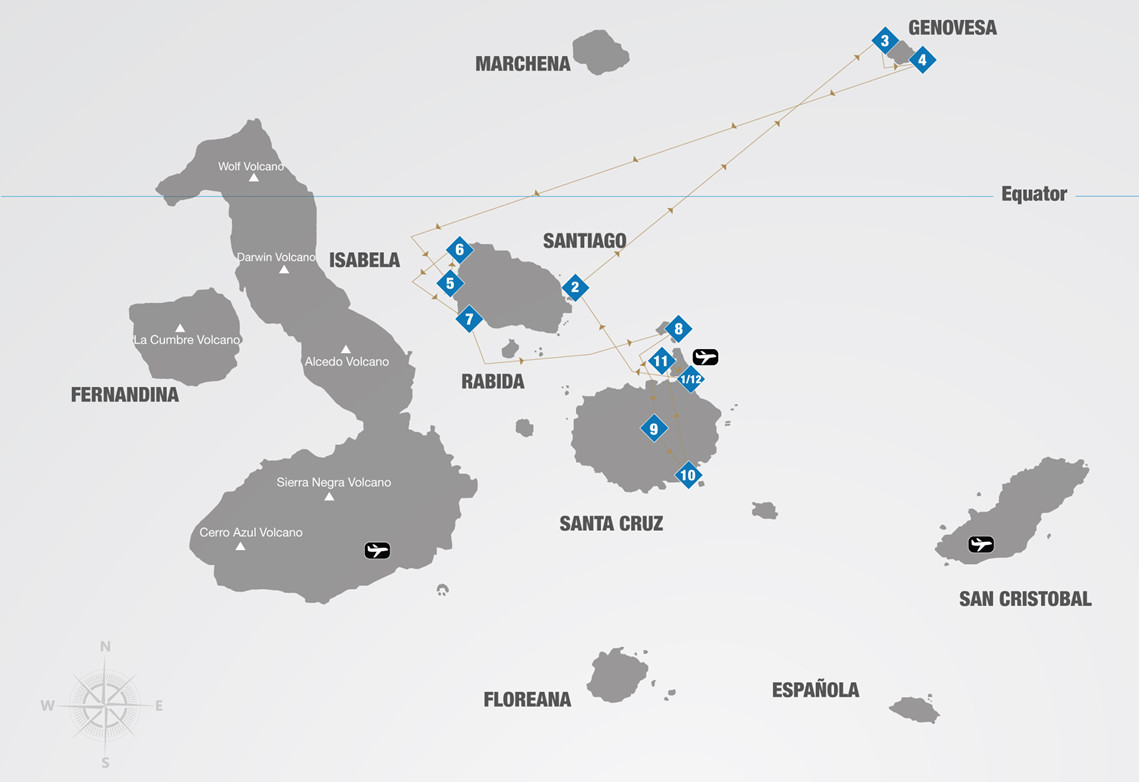
Day 1 (Tuesday) - Arrival & Pinnacle Rock
AM: Arrival to Baltra Airport, Baltra Island
Upon arrival Baltra, travellers pass through an airport inspection point to make sure that no foreign plants or animals are introduced to the islands, and to pay the park entrance fee of $200 (unless it has been prepaid). A guide will meet you, help you collect your luggage and escort you on a short bus ride to the harbour.
PM: Pinnacle Rock
Pinnacle rock is a volcanic plug, an island which was created in the vent of a volcano. Although now largely eroded, Pinnacle Rock is home to many unique species of liken and houses a Galapagos Penguin colony at the foot of the rock. In the breeding season, Pinnacle Rock is home to a nesting population of Green Sea Turtles.
Day 2 (Wednesday) - Darwin Bay & El Barranco
AM: Darwin Bay, Genovesa Island
Inside the submerged caldera of Genovesa lies Darwin Bay, whose diameter is more than 1.5km (1 mile) and it is almost 200 m (650 ft) deep. The small area will surprise you repeatedly, walking along a coral sand beach, crossing barren lava formations and creeks, passing tidal pools, shrubs and further ahead following the top of some cliffs. With this peaceful surrounding, every species has occupied its own ecological niche (or habitat) without disturbing others. There is great birdlife here with starring species including Red-Footed Boobies, Great Frigatebirds & Laval Gulls. These often share the beach with Galapagos Sea Lions.
PM: El Barranco (Prince Philip's Steps), Genovesa Island
Before landing, you will take an inflatable dinghy-ride along the eastern arm of the caldera. As we approach, the soaring 25m / 80ft high walls become overwhelming. Sometimes, a Galapagos fur seal is resting or a seabird is nesting on one of the ledges at the base. You will then have to hike and overcome the steep stairs from the landing dock to a bush of palo santo shrubs on top. Red-footed boobies gratefully use these scarce nesting places so that they don’t have to nest on the rocky ground. Upon arriving at the edge of the rim, the bushes open up and you can enjoy panoramic views, a sea breeze and the amazing flying skills of countless seabirds. Following the exposed rim, you will first pass a place where we usually encounter a colony of Nazca boobies; and finally reach the extensive storm petrel nesting places. If you are lucky, you can spot the well camouflaged short-eared owl hunting for them on foot!
Day 3 (Thursday) - Espumilla Beach / Buccaneer Cove & Egas Port
AM: Espumilla Beach / Buccaneer Cove, Santiago Island
Espumilla Beach is an important breeding site for turtles. It suffered for a period, from feral pigs which dug up turtle nests; but the beach’ natural state has been restored so the turtles return year after year to bury their eggs into the cinnamon-coloured sand dunes. 6 weeks later, during the months of February to August, the eggs hatch.
The beach ridge hides a mangle with two lagoons on the backside. A colony of American flamingos and aquatic birds used to be its main attraction, but after a previous El Niño, strong sedimentation altered the water environment, and now no longer provides their food. Vegetation zones are very close by, providing great scenic contrasts. During the climb up a hill, you will be rewarded with a beautiful view of the transitions from sea to beach and from mangrove to a dry palo santo forest.
At the nearby Buccaneers Cove, you will have the opportunity to snorkel amongst Galapagos marine life.
PM: Egas Port, Santiago Island
Puerto Egas is a black beach located at the west side of Santiago Island. Volcanic tuff deposits formed this special black sand beach and made it the main attraction of the Island. This site is called Puerto Egas because Hector Egas attempted to exploit the salt, which failed because the price of salt on mainland South America was too low to make it a viable export. There is a trail which follows the coastline here for sightings of Marine Iguanas, Galapagos Sea Lions and many sea birds. Land Iguanas were reintroduced to the island as recently as 2019, so look out for these as you walk. At the end of the trail is a small Galapagos Fur Seal colony. If you snorkel from the beach here, you may be able to see Turtles, a range of Fish and Reef Sharks.
Day 4 (Friday) - North Seymour & Santa Criz Highlands
AM: North Seymour Island
This islet is one of most visited sites in the Galapagos and it is teeming with birdlife. An easy circular path takes you through the archipelago’s most extensive colonies of blue-footed boobies and frigate birds. At the beginning of the breeding season, adult frigatebird-males blow up their vivid red pouches (gulas) to impressive football-sized balloons. This is one of the few spots where you can compare the magnificent and the great frigatebird breeding next to each other.
You are likely to come across several land iguanas on North Seymour and the coast can be a good place to spot Galapagos sealions.
PM: Highlands & Charles Darwin Research Centre, Santa Cruz Island
The road to the highlands leaves from Bellavista, a small village located a 15-minute drive from Santa Cruz’ main town of Puerto Ayora. The road passes through the Galapagos’ most productive agricultural zone, up to the National Park boundary. We find Miconia vegetation at this altitude, changing to the Fern and Sedge zone as we ascend further. With clear weather, we can enjoy beautiful scenes of rolling hills and extinct volcanic cones covered with grass and lush greenery all year round. In the Highlands is El Chato Reserve, where Giant Galapagos Tortoises can be observed in the wild – the iconic species which gave the Galapagos Islands their name. Other species to see at this reserve include Short-Eared Owls, Yellow Warblers & Finches. More elusive species which can be difficult to spot here are Galapagos Rails & Paint-Billed Crakes.
Although the great majority of Galapagos visitors come to the Charles Darwin Research Station to observe and appreciate natural wonders, it is also interesting to learn how the protection and conservation of the islands are carried out. The main attractions are the National Park information centre, the Van Staelen Exhibition Hall, the Breeding and Rearing Centre for young tortoises, and adult Galapagos tortoises in captivity.
Day 5 (Saturday) - Mosquera & Departure
AM: Mosquera Islet
Mosquera is a low white sand island which lies in the Itabaca Channel between Baltra Island (South Seymour) and North Seymour. It is surrounded by coral reefs, providing protected conditions for snorkelling and scuba diving. Above water, it has a large sealion colony and is good for spotting birds like America oyster catchers, blue-footed boobies and lava gulls.
PM: Departure from Baltra Airport, Baltra Island
Your guide & some crew members will go with you to Baltra where you will board the airport shuttle. Your guide will remain with you through the check-in counters & departure hall.
Itinerary F (4 days / 3 nights)
This itinerary is equivalent to the first 4 days of itinerary B.
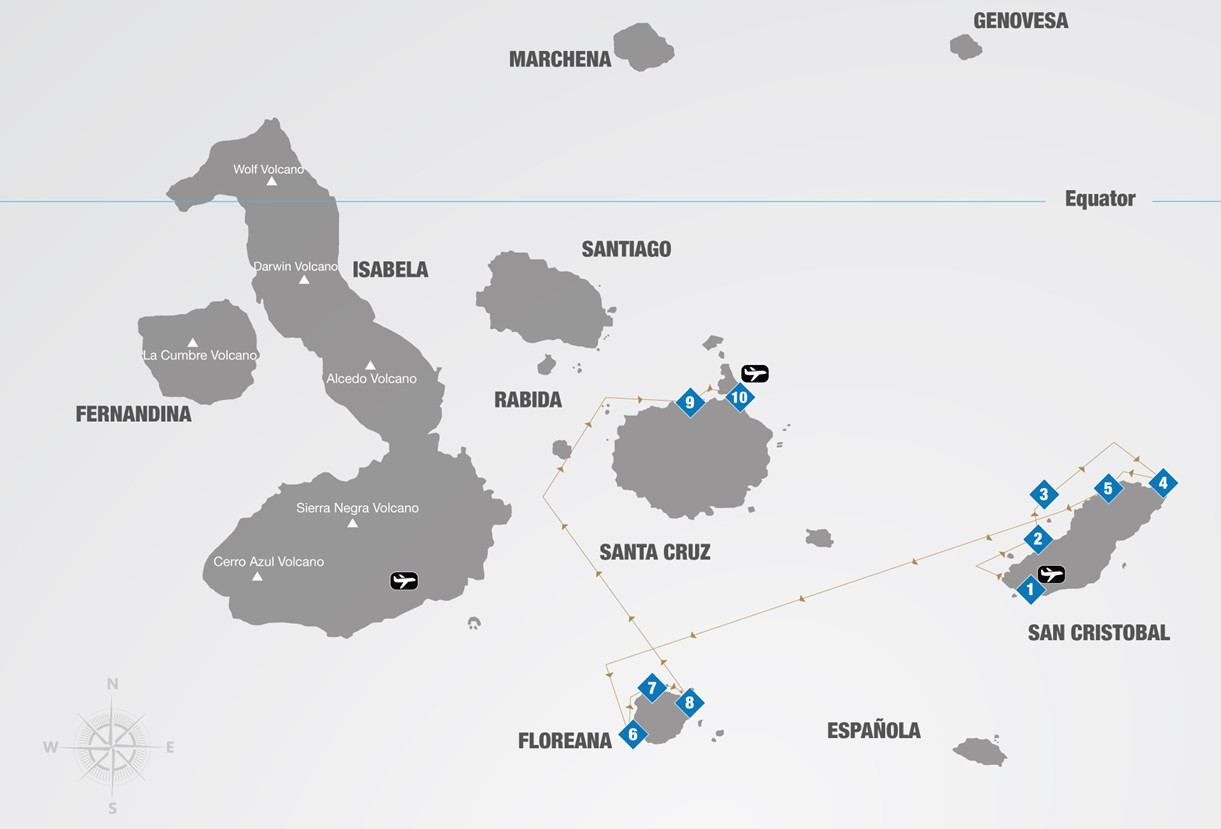
Day 1 (Saturday) - Arrival & Los Lobos Islet / Kicker Rock
AM: Arrival at San Cristobal Airport, San Cristobal Island
Land at San Cristobal airport where you will be directed towards the airport terminal building. You will need to queue here to pay your Galapagos National Park fee and have your luggage inspected for potential contaminants to the island, such as plant matter or seeds.
Please wait for you baggage to be unloaded. Collect it and then look for someone holding a card with your name or the name of your Galapagos yacht: Ocean Spray.
PM: Los Lobos Islet / Kicker Rock, San Cristobal Island
The Lobos Islets beach harbours a colony of Galapagos sea lions. As in other colonies in the archipelago, you can approach nurturing females within a few metres. In the breeding season this colony is also visited by territorial males, defending and mating the harem on their section of beach. This low islet is home to more than just Galapagos sea lions. Two other emblematic species breed here: male blue-footed boobies and great frigate birds. In season, booby males try to impress females with clumsy dances, showing off how blue (and healthy) their feet are. Male frigatebirds inflate and wobble huge red throat poaches called gulas. Young fluffy offspring cry for food, whilst juveniles try out their wings ready to fly.
Kicker Rock is the remnant of a volcanic tuff cone about a 90-minute boat ride out from San Cristobal Island which you will circumnavigate on the boat. Its sheer cliffs rise 150 metres above the sea surface, all around and through a giant split between its two sections. Above water, the rock itself and birdlife are of interest. From the sun deck, you may be able to see Pacific Green Turtles, plenty of Fish life and Galapagos Sea Lions. The variable currents here attract other marine highlights such as Spotted Eagle Rays and schools of Galapagos sharks.
Day 2 (Sunday) - Pitt Point & Witch Hill
AM: Pitt Point, San Cristobal Island
Two wind sculptured tuff cones at Pitt Point make up the extreme eastern end of San Cristóbal, and thus, the archipelago as well. These cliffs were the first sight of land when HMS Beagle and Charles Darwin arrived on the 15th of September 1835. On the small green sand beach, you will be welcomed by a group of barking Galapagos sea lions. This is a bachelor colony, where males usually relax and prepare themselves for fighting and mating.
From the saltbush and spiny shrubs behind the beach, a trail leads up to an area of tropical dry forest vegetation: most of the year you will find leafless palo santo trees, yellow Cordia shrubs, tiny Opuntia cacti and carpetweed that turns red in the dry season. After the somewhat steep climb through a gully to the clifftop, you can wander around the only location in the Galapagos that is home to all three species of boobies: blue-footed, red-footed and Nazca boobies; as well as both species of frigate bird (the Great and the Magnificent). Frigate birds are here to mug boobies as they return to their nests with food.
PM: Witch Hill, San Cristobal Island
The primary attraction of this site is the coral sand beach, an excellent place to swim and snorkel. Witch Hill is the remains of a tuff cone and one of the first sites visited by Charles Darwin. It has an impressive landscape, where it is often possible to see coastal and migratory birds, including pelicans, blue-footed boobies and swallow-tailed gulls. There are sealions and marine iguanas here too. At times, the lagoon is completely dry and deposits of salt can be found at the bottom. The people of Puerto Baquerizo Moreno used to use the lagoon as a salt mine.
Day 3 (Monday) - Post Office Bay & Cormorant Point / Devil's Crown
AM: Post Office Bay, Floreana Island
Post Office Bay is primarily of cultural significance. In times before there was a reliable postal service, a barrel onshore was a point where British 16th century whalers and poachers could post a letter. You are encouraged to write and address one or two post cards; whilst at the same time picking out any which are addressed close to your home, which you are happy to hand deliver when you return.
Shallow waters offshore are lovely to swim in. If you doon a mask and snorkel, you might see Pacific green turtles which often graze here.
PM: Cormorant Point / Devil's Crown, Floreana Island
The peninsula of Punta Cormorant (Cormorant Point) marks the extreme northern cape of Floreana – an island formed from smaller volcanic cones, covered now by tropical dry forest (palo santo). At the landing beach, you are likely to be welcomed by a small colony of Galapagos sealions. The green sand on this beach contains a high percentage of glassy olivine crystals which have been blown out by the surrounding tuff cones.
The ‘flour sand’ beach on the southern side of the peninsula is made up of white coral ground into sand by Parrotfish. It feels very smooth on the feet. You may be able to spot stingrays who use the sandy bottom to bury themselves. During the first months of the year, Pacific green turtles come ashore to dig a nest in which to bury their eggs.
Devil’s Crown is a small outcrop of rocks off the coast of Floreana near Cormorant Point with a circular arrangement which gives them their name. Here, there is spectacular snorkelling with an abundance of reef fish such as Parrotfish, Surgeonfish & King Angelfish as well as Sharks, Manta Rays & Hammerhead Sharks.
Day 4 (Tuesday) - Black Turtle Cove & Departure
AM: Caleta Tortuga Negra, Santa Cruz Island
Black Turtle Cove offers engineless activities, so you will explore it by dinghy, paddling across the mangrove forested coastline of this stretch of Santa Cruz. There is great wildlife here due to the high levels of protection of this environment such as Sea Turtles, Pelicans & Sharks.
PM: Departure from Baltra Airport, Baltra Island
Your guide & some crew members will go with you to Baltra where you will board the airport shuttle. Your guide will remain with you through the check-in counters & departure hall.
Dates
Rates subject to change in case of additional taxes, fuel price increases or other unseen circumstances.
Our prices exclude
Round trip to Galapagos
Galapagos National Park entrance fee ($200)
Transit Control Card ($20)
Alcoholic & bottled drinks
Gratuities for guide & crew
Travel & health insurance
Our prices include
Transfers in the Galapagos (between airport and boat)
Airport reception & assistance
Accommodation onboard
Guided expeditions in itinerary
Galapagos National Park guide
All meals & snacks
Soft drinks & juices
Kayaks & paddleboards
Snorkelling equipment (mask, snorkel, fins & wetsuit)
Water containers
Single Supplement
For single cabin occupancy, there is a 50% increase in cabin price from the original per person cabin price (please call to check).

